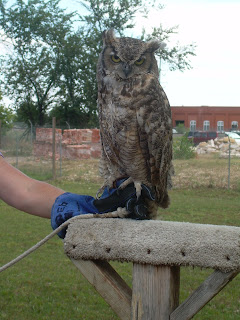One of the first things we saw was the world's smallest kestrel, which is a type of falcon. See the black feathers coming down from his eyes? That "sunglasses strategy" is where football players got the idea to use the black stripes under their eyes during games. Fighter jets are also designed after the beaks of these fast flying birds.
This great-horned owl was an amazing sight to behold. I have always wanted to see an owl in the wild so this was the highlight for me without doubt. This is the look he gave me as I walked up the hill where he was being held. His eyes are mesmerizing. They are a very bright glowing yellow, it is like looking at the parking lights of a car.
He gave us a view of his wingspan as the volunteers changed hands.
He is "panting" here because of the heat; his beak is open and the white feathers near his neck would move in and out to help reduce his body heat. He is an educational bird and was not able to go back to the wild because he has poor eyesight. He failed "the mouse test" - this is where, in a huge two story building used to re-train the recovered birds how to hunt (or see if they still can), they let prey loose for the birds. This guy couldn't find the mouse so he is now used to educate the public and volunteers.
This beautiful and small (about 8 inches tall) barn owl sat inside a small box at the entrance. So different from the great horned, with a facial disk easy to identify.





No comments:
Post a Comment